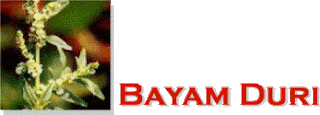Latin name: Amaranthus spinosus
Other
name(s): le xian cai, prickly amaranth, thorny
amaranth, bayam duri
Bayam duri usually grow wild in open fields
or empty gardens, along the side roads on lower grounds up to 1,400 meter above
sea level. This annual herb grows erect up to 30 – 100 centimeters high, multi-branch
with a spiny, red greenish stalk, which is smooth on the base and a little
fuzzy at the top. The single leaf has a long stalk, egg-shaped with a blunt
tip, smooth edges and is 1.5 - 6 centimeters long and 1 – 3 centimeters wide
and green in color.
At the leaf joint grows a pair of fragile
thorns. The female flowers rise from the leaf joint, blooming round and close
to each other, while the white greenish male flower is cone shaped, rising out
in branches at the leaf joint or tip of the stalk. It has a green tubular fruit
with black, small round seeds.
Bayam duri roots has a bitter sweet and
cooling taste that enters the meridian of the heart and kidneys. It contains
amaranthine, rutine, spinasterol, tanine, potassium nitrate, potassium oxalate,
phosphate salt, ferrum, vitamin A, B, K and B6 (pyridoxin)
MEDICINAL
PART: Roots and leaves
THERAPEUTIC EFFECTS: Root: antipyretic, diuretic, emenagogue,
antitoxic, reduce swelling, blood cleansing
INDICATION: Root: dysentery, diarrhea;
laryngitis, toothache, fever; bronchitis; scrofuloderma (lymph tuberculosis); leukorrhea;
infection of the uterus; amenorrhea; scanty urination (oliguria); gonorrhea;
gallstone. Leaves: chest pain; acute bronchitis; anemia and lack of lactation.
DOSAGE AND USAGE: Decoction: boil 10 – 15
grams of dried root or 30 – 60 grams of the fresh roots, cool off and drink. Or
boil ½ to 1 handful of the fresh whole herb, cool off and drink. External use:
boil adequate amount of the whole herb, and use the liquid to wash the affected
part e.g. warts, cuticles, hemorrhoids, eczema, bleeding gums, to stimulate
lactation (lactagogue), fever, burn wounds, snakebites. For patients with
rheumatism: soak the affected joint or ankle in the liquid while warm.
Usage and dosage for some specific conditions
are as follows:
Dysentery: Wash 30 grams of bayam duri fresh roots and cut to
small pieces. Boil in 2 glasses of water and add 15 grams of palm sugar, stir
well and wait until left to ½ glass. Strain after cooling, and drink at once
before meal. Do this twice per day until the condition gets better.
Leukorrhea: : Wash 30 – 60 grams of bayam duri fresh roots and cut
to small pieces. Boil in 3 glasses of water and add 15 grams of rock sugar,
stir well and wait until left to1 glass. Strain after cooling, divide into 2
portion to be taken twice a day, morning and afternoon.
Laryngitis: Wash 45 grams of bayam duri fresh roots and cut to
small pieces. Boil in 3 glasses of water until left to1 glass. Strain after
cooling. Drink ½ glass 2 times a day, in the morning and afternoon.
Bronchitis: Wash ½ handful of bayam duri root and grind to a fine
mush. Add 3 tablespoon boiled water and a little salt, stir well, squeeze and
strain the sap. Drink at once and repeat this 2 times per day.
Toothache: Wash bayam duri root, and chew it in the mouth
Amenorrhea: Wash 50 grams of the root and cut to small pieces. Soak
it in adequate amount of red wine, then steam about 15 minutes. Drink at once
while warm.
Scrofuloderma: Wash 30 – 60 grams of the whole herb and cut to small
pieces. Boil with 1.5 glasses of water and 1.5 glasses of white wine until left
to 1 glass. Strain after cooling. Drink ½ glass 2 times a day.
Oliguria (scanty urination): Wash one root of this herb and cut
to pieces. Boil with 2 glasses of pure water until left to 1 glass. Strain
after cooling, and drink at once in the morning
Warts: Wash adequate amount of bayam duri
leaves and stalk, cut to pieces. Grind to a fine mushy substance. Add 1
teaspoon of honey and stir well until even. Apply to the wart and surrounding area
and put on a bandage. Change the bandage and remedy 3 times a day.
Hemorrhoids: Wash and boil adequate amount of fresh leaves and
stalk. Apply steam to the hemorrhoid and then soak the hemorrhoid in the
remaining liquid.
Eczema:
Wash the whole herb and cut to pieces. Soak in adequate amount of water and let
it boil for 15 minutes. Add a little salt and stir well. Use the water to wash
and compress the affected area.
Bleeding gums: Burn the whole dried plant using a ceramic plate, and
then grind to powder. Apply this black powder to the affected gum frequently
until the condition gets better.
Lactagogue: Wash a stalk of bayam duri and then fine grind the herb
to a mushy substance. Apply to breast and surrounding area. Do this 3 – 4 times
a day until lactation becomes smoothly.
Fever:
Wash and grind a handful of bayam duri leaves and stalk. Add adequate amount of
hot water, stir until a mucus substance and apply on forehead and temple as
compress
CONTRA-INDICATIONS: None
IMPORTANT NOTE
The recipes and
techniques mentioned in this page are not meant to replace diagnosis and
treatment of a medical practioner. Before using any of these recipes, the
author recommends to consult a physician. All the recipes has been used without
any side effects and are considered safe. However, since some people have more
sensitive skin or digestive system than others, and since the user’s actual
recipe preparation is beyond the control of the author, the author accept no
liability with regard to the use of recipes or techniques contained in this
page







